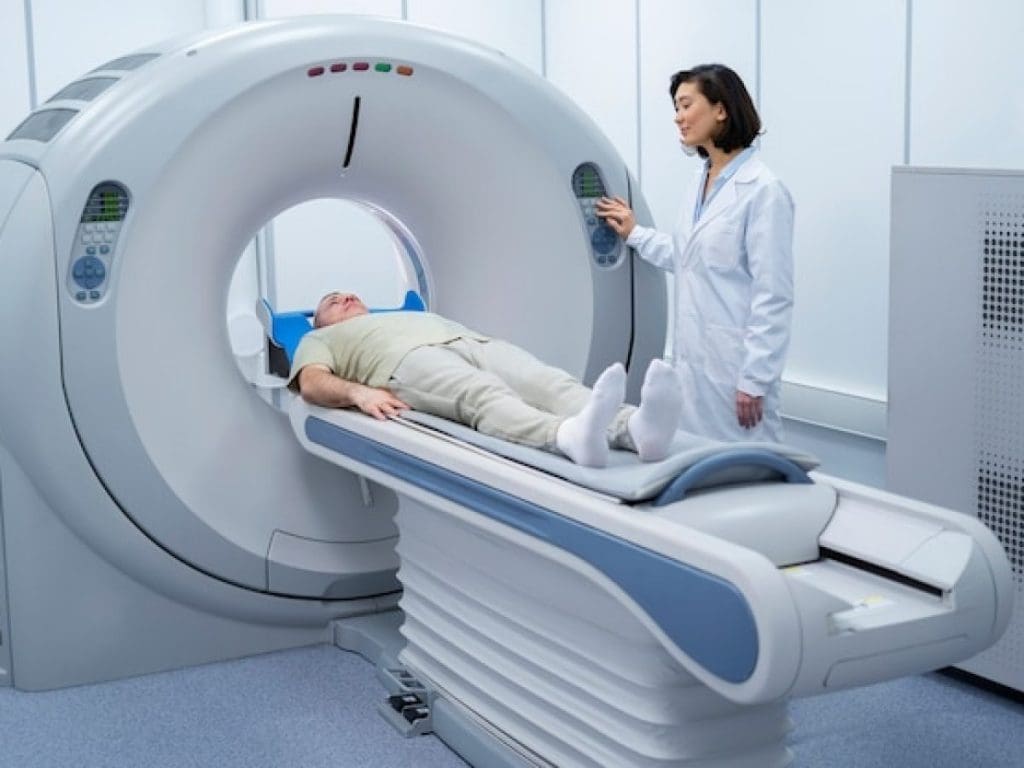Last Updated on November 27, 2025 by Bilal Hasdemir
Over 1.5 million PET scans are done every year in the United States. They help find and treat many health issues.
A PET scan, or Positron Emission Tomography, is a medical test that shows how the body works. It uses a special tracer that highlights activity inside the body. Many patients wonder, “can I drive after a PET scan?”and in most cases, the answer depends on the type of tracer and sedation used during the procedure.
After a PET scan, people often ask if they can drive home. The answer depends on the tracer used and the patient’s health.
Key Takeaways
- Understand what a PET scan is and its role in medical diagnosis.
- Learn about the factors that determine whether you can drive after a PET scan.
- Discover the safety precautions to consider after undergoing a PET scan.
- Find out what to expect during and after the PET scan procedure.
- Get insights into the guidelines for driving after a PET scan.
What Is a PET Scan and How Does It Work?

A PET scan is a high-tech way to see how the body works. It helps find diseases early. This tool is key for checking how the body functions and spotting problems.
Definition of Positron Emission Tomography
Positron Emission Tomography, or PET, is a special imaging method. It uses a tiny bit of radioactive material to find and treat diseases. This includes cancer, brain issues, and heart problems. The PET scan machine makes detailed pictures of the body’s inside.
The Science Behind PET Imaging Technology
PET imaging works by finding diseases through body changes. First, a radioactive tracer is given to the body. It goes to areas that are very active, like growing tumors. Then, the PET scan machine picks up the signals from the tracer, making clear images of where the disease is.
Types of Radioactive Tracers Used
Different tracers are used for PET scans, each for a specific purpose. The most used is Fluorodeoxyglucose (FDG) for finding cancer. Other tracers help with brain and heart issues.
| Tracer Name | Application |
| Fluorodeoxyglucose (FDG) | Cancer detection, tumor assessment |
| Flortaucipir | Neurological conditions, Alzheimer’s disease |
| Rubidium-82 | Cardiovascular disease evaluation |
Knowing about the different tracers helps us see how PET scans work. They let understand the body’s metabolism. This helps in diagnosing and treating many diseases.
Common Reasons Why Order PET Scans
PET scans help understand how our bodies work. They are key in finding and treating many health problems. This makes them a vital tool in today’s medicine.
Cancer Detection and Staging
often use PET scans to find and check cancer. They help spot cancer cells and see how far the disease has spread. This info is key for planning treatment.
- Identifying cancerous tumors and their metabolic activity
- Staging cancer to determine the extent of disease spread
- Monitoring treatment response and detecting recurrence
Neurological Conditions Assessment
PET scans also help with brain-related issues like Alzheimer’s and Parkinson’s. They show brain activity, helping diagnose and treat these conditions sooner.
- Diagnosing neurodegenerative diseases like Alzheimer’s and Parkinson’s
- Evaluating seizure activity in epilepsy patients
- Assessing brain function and activity in various neurological disorders
Cardiovascular Disease Evaluation
PET scans are also used for heart health. They check how well the heart works and find any problems with blood flow. This helps see if heart tissue is healthy.
PET scans are a powerful tool for diagnosing many health issues. They give important information to make treatment plans. Knowing why use PET scans helps patients understand their care better.
Preparing for Your PET Scan: Essential Guidelines
A successful PET scan needs careful preparation. This includes changing your diet and managing your medications. It’s important to follow your healthcare provider’s guidelines for a smooth and safe procedure.
Dietary Restrictions Before the Procedure
Before your PET scan, you might need to stick to a special diet. This diet usually means avoiding sugary foods and drinks for a while before the scan. It’s very important to follow these dietary restrictions to get clear PET scan images.
| Food/Drink | Allowed | Not Allowed |
| Sugary foods and drinks | ✔ | |
| Caffeine | ✔ | |
| Water | ✔ |
Medications to Avoid Before a PET Scan
Some medications can affect the PET scan results. Tell your about all medications you’re taking, including supplements and vitamins. Your might ask you to stop or adjust some medications before the scan.
What to Wear and Bring to Your Appointment
On the day of your PET scan, wear comfy clothes and avoid metal. Bring any medical records, insurance info, and a list of your medications.
By following these guidelines, you help make your PET scan safe and effective. This gives your healthcare team the info they need to make accurate diagnoses and treatment plans.
The Complete PET Scan Procedure Explained
A PET scan procedure has several steps, from getting ready to the actual scan. Knowing these steps can make patients feel more at ease and ready for their visit.
Arrival and Initial Preparation Steps
When you arrive, you’ll change into a hospital gown. This is to make sure there’s no metal that could mess with the scan. Then, you’ll sit or lie down in a comfy spot. The medical team will explain the process and answer any questions you have.
The room is dimly lit to help you relax. An IV line is put in your arm or hand. This is for the radioactive tracer.
Injection of the Radioactive Tracer
The radioactive tracer is given through the IV line. The tracer used depends on the scan’s purpose. For example, fluorodeoxyglucose (FDG) is often used for cancer scans. It goes to areas with high activity, like growing cancer cells.
The Scanning Process in Detail
After the tracer circulates and builds up (usually 30-60 minutes), you’ll get on a table. This table slides into the PET scanner. The scanner picks up signals from the tracer to make detailed images of your body’s inside.
The scan takes about 30 to 60 minutes, based on the scan type and area. You must stay very quiet to get clear images.
| Step | Description | Duration |
| Initial Preparation | Changing into a hospital gown, IV insertion | 15-30 minutes |
| Tracer Injection and Uptake | Injection of radioactive tracer, waiting for uptake | 30-60 minutes |
| Scanning | Positioning on the table, scanning with the PET machine | 30-60 minutes |
By knowing the PET scan procedure, patients can better prepare for their visit. They’ll know what to expect during the process.
Potential Side Effects and Risks of PET Scans
It’s important to know the side effects and risks of PET scans. They are a key tool for , but they use radioactive tracers. This can affect your health.
Common Minor Side Effects to Expect
Most people don’t feel much after a PET scan. But, some might notice:
- Mild discomfort or pain at the injection site
- Temporary changes in blood pressure
- A metallic taste in the mouth after the tracer injection
These effects usually go away quickly and don’t need medical help.
Rare but Serious Complications
Even though they’re rare, serious problems can happen. These include:
- Allergic reactions to the radioactive tracer
- Severe issues from the injection, like infection or blood clots
Tell your about any allergies or sensitivities before the scan.
Radiation Exposure Concerns and Safety
Radiation is a big worry with PET scans. The amount is usually safe, but it’s not zero. Here’s a comparison:
| Procedure | Effective Dose (mSv) |
| PET Scan | 5-20 |
| Chest X-ray | 0.1 |
Keeping patients safe during PET scans is a big deal. Knowing the risks helps you make smart choices about your health.
Post-PET Scan Precautions You Should Follow
After a PET scan, it’s important to take steps to protect yourself and others. The scan uses a radioactive tracer. This means you need to follow certain precautions to stay safe.
Managing Radioactivity After Your Scan
The tracer in PET scans breaks down quickly. But, there are steps you can take to reduce exposure to others. Drink plenty of fluids to help clear the tracer from your body. Also, void your bladder frequently to keep the tracer’s concentration low.
Interactions with Others Following Your Procedure
When the tracer is in your system, it’s wise to keep a distance from others. This is true for pregnant women and young children, as they are more vulnerable to radiation. Maintain a safe distance from others for the day. Also, avoid close contact like hugging or sharing utensils.
When to Contact Your Healthcare Provider
If you feel unusual symptoms after the scan, like a severe headache or dizziness, contact your healthcare provider immediately. Such reactions are rare, but it’s key to watch how your body reacts.
By following these precautions, you can reduce risks and ensure a safe recovery after your PET scan.
Can I Drive Myself Home After a PET Scan?
Many patients wonder if they can drive home after a PET scan. The answer depends on the PET scan type, the patient’s health, and their advice.
Official Medical Recommendations for Transportation
usually say no to driving home after a PET scan. The tracer used can make some people feel sleepy or dizzy. Also, the stress of the procedure can affect driving skills.
It’s best to have someone drive you home after the scan. This keeps everyone safe on the road.
Factors Affecting Your Ability to Drive Safely
Several things can affect your ability to drive safely after a PET scan:
- The type and amount of radioactive tracer used
- The patient’s overall health and any underlying medical conditions
- Any medications taken before or after the procedure
- The patient’s level of comfort and alertness after the scan
Alternative Transportation Options to Consider
If you can’t drive yourself home, there are other ways to get there:
| Transportation Option | Description | |
| Family/Friend | Ask a family member or friend to pick you up | Free |
| Taxi/Ride-hailing | Use a taxi or ride-hailing service like Uber or Lyft | Varies |
| Public Transport | Use buses or trains if available and feasible | Varies |
Legal and Implications of Driving Post-Procedure
Driving after a PET scan can have legal and insurance issues. If you drive against orders and get into an accident, your insurance might not cover it. Always listen to your to avoid legal and financial problems.
In conclusion, while it’s tempting to drive home after a PET scan, safety comes first. Always follow your advice on transportation to keep yourself and others safe.
How Long Are You Radioactive After a PET Scan?
PET scans use radioactive tracers. Knowing how long the radioactivity lasts is key for patients. The tracers in PET scans decay fast because of their short half-life.
Typical Radioactive Decay Timeline
The tracer in PET scans, like Fluorodeoxyglucose (FDG), has a half-life of about 110 minutes. This means its radioactivity halves every 110 minutes. In a few hours, the radioactivity drops a lot.
| Time Elapsed | Radioactivity Level |
| 0 hours | 100% |
| 2 hours | 25% |
| 4 hours | 6.25% |
| 6 hours | 1.56% |
Precautions During the Radioactive Period
Even though radioactivity drops fast, patients should be careful after a PET scan. They should drink lots of water to flush out the tracer. They should also avoid close contact with pregnant women and kids for a few hours.
Special Considerations for Specific Patient Groups
Some patients need extra care. For example, breastfeeding moms should pump and discard their milk for a while after the scan. Anyone planning to get pregnant should tell their .
Knowing the radioactivity timeline and taking precautions helps patients stay safe after a PET scan.
Conclusion
Knowing about PET scans is key for patients going through them. These scans are great for finding cancer, checking the brain and heart, and more. They help see what’s going on inside the body.
A PET scan works by using a special dye that shows up in active areas. This dye helps make clear images. These images help them find and track diseases.
After a PET scan, patients need to follow some rules. They should manage how they deal with the dye’s radioactivity. They also need to think about how to get home safely, as they might not be able to drive.
In short, PET scans are a big help in understanding the body. By knowing how they work, patients can feel more in control of their health. This knowledge helps them make better choices about their care.
FAQ
What should I expect during a PET scan?
During a PET scan, you’ll get a radioactive tracer and then lie in a scanner. It’s usually painless but might feel uncomfortable or scary.
Can I drive myself home after a PET scan?
No, you shouldn’t drive after a PET scan. The tracer and any sedation might make it hard to drive safely. Plan for someone else to drive you home.
How long do I remain radioactive after a PET scan?
The radioactive tracer in a PET scan goes away quickly. Most of it leaves your body in a few hours. You’ll need to drink lots of water and avoid being close to others for a bit.
How long does a PET scan take?
A PET scan usually takes 30 minutes to a few hours. This depends on the type of scan and what it needs to do.






